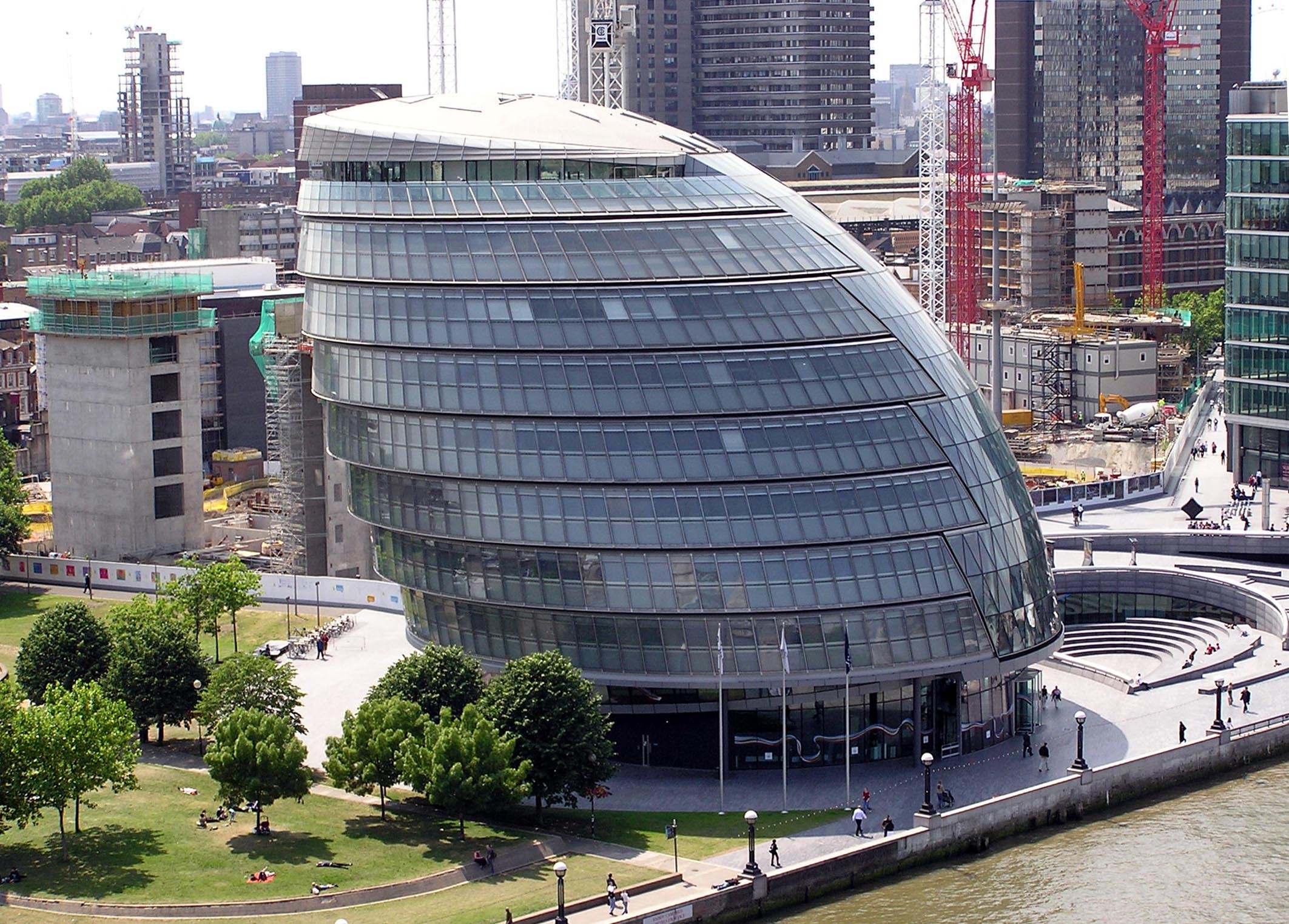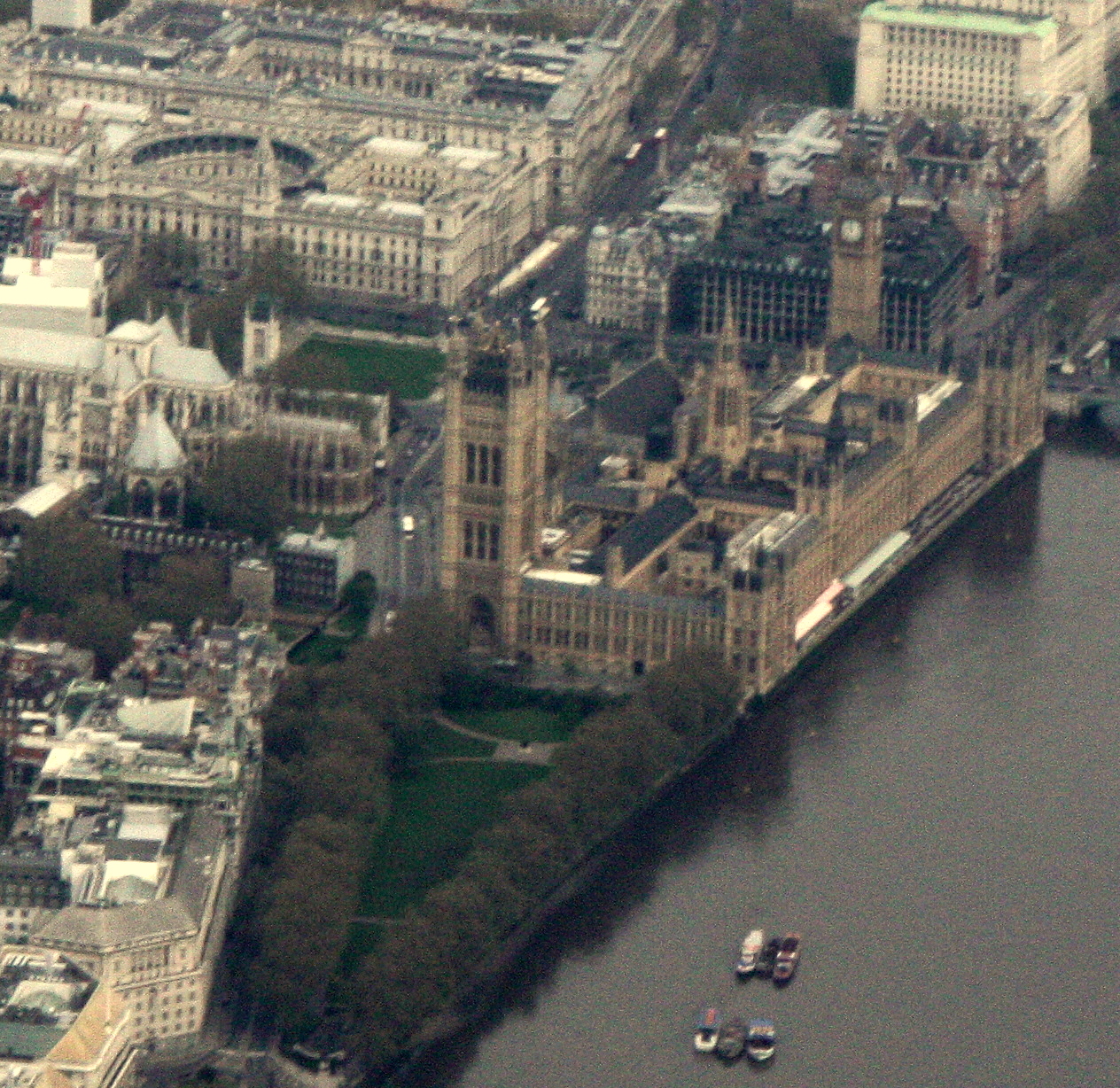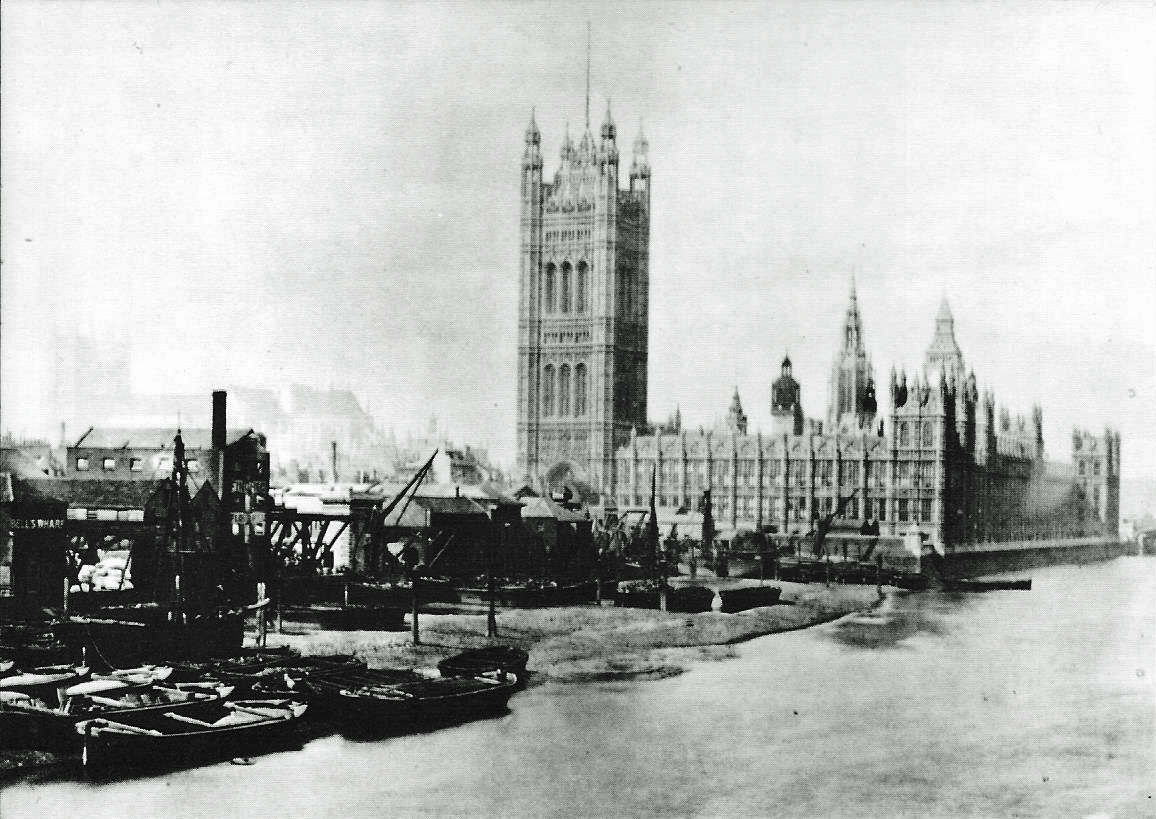|
Parliament Square
Parliament Square is a square at the northwest end of the Palace of Westminster in the City of Westminster in central London. Laid out in the 19th century, it features a large open green area in the centre with trees to its west, and it contains twelve statues of statesmen and other notable individuals. As well as being one of London's main tourist attractions, it is also the place where many demonstrations and protests have been held. The square is overlooked by various official buildings: legislature to the east (in the Houses of Parliament), executive offices to the north (on Whitehall), the judiciary to the west (the Supreme Court), and the church to the south (with Westminster Abbey). Location Buildings looking upon the square include the churches Westminster Abbey and St Margaret's, Westminster, the Middlesex Guildhall which is the seat of the Supreme Court of the United Kingdom, Government Offices Great George Street serving HM Treasury and HM Revenue and Customs, a ... [...More Info...] [...Related Items...] OR: [Wikipedia] [Google] [Baidu] |
Parliament Square 1980
In modern politics, and history, a parliament is a legislative body of government. Generally, a modern parliament has three functions: representing the electorate, making laws, and overseeing the government via hearings and inquiries. The term is similar to the idea of a senate, synod or congress and is commonly used in countries that are current or former monarchies. Some contexts restrict the use of the word ''parliament'' to parliamentary systems, although it is also used to describe the legislature in some presidential systems (e.g., the Parliament of Ghana), even where it is not in the official name. Historically, parliaments included various kinds of deliberative, consultative, and judicial assemblies, an example being the French medieval and early modern parlements. Etymology The English term is derived from Anglo-Norman and dates to the 14th century, coming from the 11th century Old French , "discussion, discourse", from , meaning "to talk". The meaning evol ... [...More Info...] [...Related Items...] OR: [Wikipedia] [Google] [Baidu] |
Birdcage Walk
Birdcage Walk is a street in the City of Westminster in London. It runs east–west as a continuation of Great George Street, from the crossroads with Horse Guards Road and Storey's Gate, with the Treasury building and the Institution of Mechanical Engineers on the northeast corner, to a junction with Buckingham Gate, at the southeast corner of Buckingham Palace. St. James's Park lies to the north, whilst to the south are the backs of buildings on Old Queen Street, Queen Anne's Gate and Petty France, and, at the western end, the Wellington Barracks of the Brigade of Guards. History The street is named after the Royal Menagerie and Aviary which were located there in the reign of King James I. King Charles II expanded the Aviary when the Park was laid out from 1660. Samuel Pepys and John Evelyn both mention visiting the Aviary in their diaries. [...More Info...] [...Related Items...] OR: [Wikipedia] [Google] [Baidu] |
Reclaim The Streets
Reclaim the Streets also known as RTS, are a collective with a shared ideal of community ownership of public spaces. Participants characterise the collective as a resistance movement opposed to the dominance of corporate forces in globalisation, and to the car as the dominant mode of transport. Reclaim the Streets often stage non-violent direct action street reclaiming events such as the 'invasion' of a major road, highway or motorway to stage a party. While this may obstruct the regular users of these spaces such as car drivers and public bus riders, the philosophy of RTS is that it is vehicle traffic, not pedestrians, who are causing the obstruction, and that by occupying the road they are in fact opening up public space. The events are usually spectacular and colourful, with sand pits for children to play in, free food and music, however they have been known to degenerate into riots and violence. Reclaim The Streets was originally formed by Earth First! Past acti ... [...More Info...] [...Related Items...] OR: [Wikipedia] [Google] [Baidu] |
Allotment (gardening)
An allotment (British English), or in North America, a community garden, is a plot of land made available for individual, non-commercial gardening or growing food plants, so forming a kitchen garden away from the residence of the user. Such plots are formed by subdividing a piece of land into a few or up to several hundred parcels that are assigned to individuals or families. Such parcels are cultivated individually, contrary to other community garden types where the entire area is tended collectively by a group of people. In countries that do not use the term "allotment (garden)", a "community garden" may refer to individual small garden plots as well as to a single, large piece of land gardened collectively by a group of people. The term "victory garden" is also still sometimes used, especially when a community garden dates back to the First or Second World War. The individual size of a parcel typically suits the needs of a family, and often the plots include a shed for tools ... [...More Info...] [...Related Items...] OR: [Wikipedia] [Google] [Baidu] |
May Day
May Day is a European festival of ancient origins marking the beginning of summer, usually celebrated on 1 May, around halfway between the spring equinox and summer solstice. Festivities may also be held the night before, known as May Eve. Traditions often include gathering wildflowers and green branches, weaving floral garlands, crowning a May Queen (sometimes with a male companion), and setting up a Maypole, May Tree or May Bush, around which people dance. Bonfires are also part of the festival in some regions. Regional varieties and related traditions include Walpurgis Night in central and northern Europe, the Gaelic festival Beltane, the Welsh festival Calan Mai, and May devotions to the Blessed Virgin Mary. It has also been associated with the ancient Roman festival Floralia. In 1889, 1 May was chosen as the date for International Workers' Day by the Second International, to commemorate the Haymarket affair in Chicago and the struggle for an eight-hour working day. ... [...More Info...] [...Related Items...] OR: [Wikipedia] [Google] [Baidu] |
Bylaw
A by-law (bye-law, by(e)law, by(e) law), or as it is most commonly known in the United States bylaws, is a set of rules or law established by an organization or community so as to regulate itself, as allowed or provided for by some higher authority. The higher authority, generally a legislature or some other government body, establishes the degree of control that the by-laws may exercise. By-laws may be established by entities such as a business corporation, a neighborhood association, or depending on the jurisdiction, a municipality. In the United Kingdom and some Commonwealth countries, the local laws established by municipalities are referred to as ''by(e)-laws'' because their scope is regulated by the central governments of those nations. Accordingly, a bylaw enforcement officer is the Canadian equivalent of the American Code Enforcement Officer or Municipal Regulations Enforcement Officer. In the United States, the federal government and most state governments have no dire ... [...More Info...] [...Related Items...] OR: [Wikipedia] [Google] [Baidu] |
Greater London Authority Act 1999
The Greater London Authority Act 1999 (c. 29) is the Act of Parliament that established the Greater London Authority, the London Assembly and the Mayor of London. Background The Act was brought in after a referendum was held under the Greater London Authority (Referendum) Act 1998 (c. 3). The referendum question was: 'Are you in favour of the Government's proposals for a Greater London Authority, made up of an elected mayor and a separately elected assembly?' The Yes vote was 72.01%, the No vote was 27.99%. Provisions Apart from the main provisions creating the authority and transferring powers to it, it also created a Metropolitan Police Authority for the Metropolitan Police Service, and consequently altered the borders of the Metropolitan Police District to be coterminous with Greater London (excluding the City). The Act comprises 425 Sections in 12 Parts including 22 named Chapters and 34 Schedules. It was the longest Act to be passed by Parliament since the Governmen ... [...More Info...] [...Related Items...] OR: [Wikipedia] [Google] [Baidu] |
Greater London Authority
The Greater London Authority (GLA), colloquially known by the metonym "City Hall", is the devolved regional governance body of Greater London. It consists of two political branches: the executive Mayoralty (currently led by Sadiq Khan) and the 25-member London Assembly, which serves as a means of checks and balances on the former. Since May 2016, both branches have been under the control of the London Labour Party. The authority was established in 2000, following a local referendum, and derives most of its powers from the Greater London Authority Act 1999 and the Greater London Authority Act 2007. It is a strategic regional authority, with powers over transport, policing, economic development, and fire and emergency planning. Three functional bodies— Transport for London, the Mayor's Office for Policing and Crime, and the London Fire Commissioner—are responsible for delivery of services in these areas. The planning policies of the Mayor of London are detailed in a s ... [...More Info...] [...Related Items...] OR: [Wikipedia] [Google] [Baidu] |
Parliamentary Estate
The Parliamentary Estate is the land and buildings used by the Parliament of the United Kingdom. The most notable part of the Parliamentary Estate is the Palace of Westminster, where the chambers of both houses of Parliament (the Commons and the Lords) are located.Other buildings on the Parliamentary Estate , Parliament of the United Kingdom (accessed 16 December 2015). The oldest part of the Palace of Westminster is , the historic core of the building; the present-day Palace of Westminster was built after a major fire in 1834< ... [...More Info...] [...Related Items...] OR: [Wikipedia] [Google] [Baidu] |
George Grey Wornum
George Grey Wornum (17 April 1888 – 11 June 1957) was a British architect. Grey Wornum was born in London and educated at Bradfield College and the Slade School of Art. He studied architecture under the guidance of his uncle, Ralph Selden Wornum. Badly wounded in the First World War he suffered leg injuries and the loss of his right eye, which had no effect on his subsequent achievements as an architect. He married the American designer Miriam Alice Gerstle in 1923. In his later years he spent some time in Bermuda for health reasons. He died in New York City and was named CBE in the Birthday Honours list published two days after his death. Achievements Wornum was winner of the Royal Gold Medal for Architecture in 1952. His notability rests upon his design of the RIBA Building, the Royal Institute of British Architects' Headquarters at 66 Portland Place, London. Wornum's entry was judged the best of 3600 in the competition for a new RIBA headquarters. Completed in 1934, the build ... [...More Info...] [...Related Items...] OR: [Wikipedia] [Google] [Baidu] |
Victoria Tower Gardens
Victoria Tower Gardens is a public park along the north bank of the River Thames in London, adjacent to the Victoria Tower, at the south-western corner of the Palace of Westminster. The park, extends southwards from the Palace to Lambeth Bridge, between Millbank and the river. It forms part of the Thames Embankment. Victoria Tower Gardens is a Grade II* listed park created in two stages in 1879–81 and 1913–14. It is in a conservation area, is partly within the UNESCO World Heritage Site of Westminster, and is designated a zone of Monument Saturation. History The northern part of the gardens was acquired by the Government under the Houses of Parliament Act 1867 in order to reduce the fire risk to the Palace of Westminster from the wharves there. There was disagreement about whether at least some of the land should be built on, but eventually the newspaper retailer William Henry Smith donated £1000 towards laying it out as an open space and Parliament paid the remai ... [...More Info...] [...Related Items...] OR: [Wikipedia] [Google] [Baidu] |
Buxton Memorial Fountain
The Buxton Memorial Fountain is a memorial and drinking fountain in London, the United Kingdom, that commemorates the Abolitionism in the United Kingdom, emancipation of slavery, slaves in the British Empire in 1834, and in particular, the role of Member of Parliament (United Kingdom), British parliamentarians in the abolition campaign. It was commissioned by Charles Buxton MP, and was dedicated to his father Thomas Fowell Buxton along with William Wilberforce, Thomas Clarkson, Thomas Babington Macaulay, 1st Baron Macaulay, Thomas Babington Macaulay, Henry Brougham, 3rd Baron Brougham and Vaux, Henry Brougham and Stephen Lushington (judge), Stephen Lushington, all of whom were involved in the abolition. It was designed by Charles Buxton, who was himself an amateur architect, in collaboration with the Gothic Revival architecture, neo-Gothic architect Samuel Sanders Teulon (1812–1873) in 1865. It coincided with the passing of the Thirteenth Amendment to the United States Constituti ... [...More Info...] [...Related Items...] OR: [Wikipedia] [Google] [Baidu] |




_by_Antonio_Reyna_Manescau.jpg)





